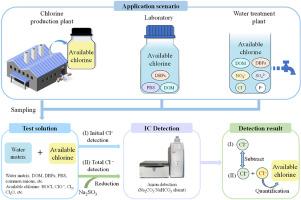一种检测低浓度游离可得氯的简便还原法--利用亚硫酸钠作为淬灭剂。
IF 8.1
2区 环境科学与生态学
Q1 ENVIRONMENTAL SCIENCES
引用次数: 0
摘要
作为主流消毒剂的氯会与溶解有机物 (DOM) 发生反应,形成不应有的消毒副产物 (DBP)。游离可得氯(FAC)的浓度对于确保有效消毒,同时最大限度地减少有毒 DBPs 的形成至关重要。在这项研究中,我们提出了一种使用亚硫酸钠(Na2SO3)还原游离可得氯中氧化氯的简便方法。还原氯离子(Cl-)的摩尔浓度通过离子色谱法直接定量,以反映 FAC 的浓度。与常见的 FAC 检测技术(包括 DPD 比色法、碘测定法和紫外法)相比,这种新型还原法的检测限更低,抗干扰能力更强。常见的水基质(如 DOM 和阴离子)不会影响该方法的准确性(< 3.6%)。此外,采用这种还原法测定碳质 DBP(C-DBP),如受管制的三卤甲烷和卤乙酸、未受管制的芳香族氯酚,也不会对 FAC 的测定产生干扰。这种不干扰可归因于 Na2SO3 的氧化还原电位较低,不易与这些 C-DBPs 发生反应。然而,二氯乙腈等氮化 DBPs(N-DBPs)则显示出轻微的干扰(水中普通二氯乙腈浓度对 FAC 的影响小于 0.0007 μM)。这表明该方法非常适合在氯化过程中测定以 C-DBPs 为主的 FAC。总之,还原法可以精确测定 FAC,对于评估实验室和以 C-DBPs 为主的实际消毒水样中的余氯水平都很有价值。本文章由计算机程序翻译,如有差异,请以英文原文为准。

A convenient reduction method for the detection of low concentration free available chlorine——utilizing sodium sulfite as a quencher
Chlorine, serving as the mainstream disinfectant, can react with dissolved organic matter (DOM) to form undeserved disinfection by-products (DBPs). Free available chlorine (FAC) concentration is crucial to ensure effective disinfection while minimizing the formation of toxic DBPs. In this study, we propose a convenient method using sodium sulfite (Na2SO3) to reduce oxidized chlorine in FAC. The molar concentration of reduced chloride ion (Cl−) was quantified directly by ion chromatography to reflect FAC concentration. Compared with common FAC detection techniques including DPD colorimetry, iodometry, and UV methods, this novel reduction method exhibits a lower detection limit and is more resistant to interference. Common water matrices, such as DOM and anions did not affect the method accuracy (< 3.6%). Furthermore, carbonaceous DBPs (C-DBPs) like regulated trihalomethanes and halogenacetic acids, unregulated aromatic chlorophenols, did not interfere with the determination of FAC by using this reduction method. This lack of interference can be attributed to the low redox potential of Na2SO3, which does not readily react with these C-DBPs. However, nitrogenated DBPs (N-DBPs) like dichloroacetonitrile displayed slight interference (the effect of common dichloroacetonitrile concentration in water on FAC was less than 0.0007 μM). This suggests that this method is well-suited for determining FAC in chlorination processes where the C-DBPs predominated. Overall, the reduction method enables precise determination of FAC and proves valuable in assessing residual chlorine levels in both laboratory and real disinfected water samples dominated by C-DBPs.
求助全文
通过发布文献求助,成功后即可免费获取论文全文。
去求助
来源期刊

Chemosphere
环境科学-环境科学
CiteScore
15.80
自引率
8.00%
发文量
4975
审稿时长
3.4 months
期刊介绍:
Chemosphere, being an international multidisciplinary journal, is dedicated to publishing original communications and review articles on chemicals in the environment. The scope covers a wide range of topics, including the identification, quantification, behavior, fate, toxicology, treatment, and remediation of chemicals in the bio-, hydro-, litho-, and atmosphere, ensuring the broad dissemination of research in this field.
 求助内容:
求助内容: 应助结果提醒方式:
应助结果提醒方式:


